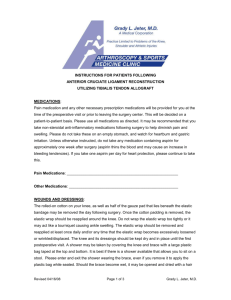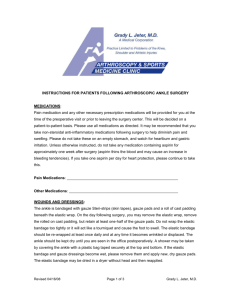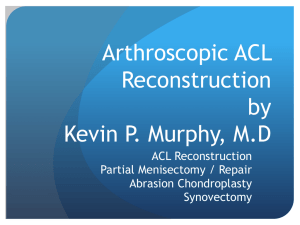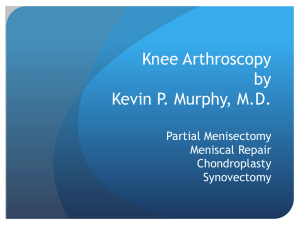Arthroscopic Lateral Retinacular Release Post
advertisement
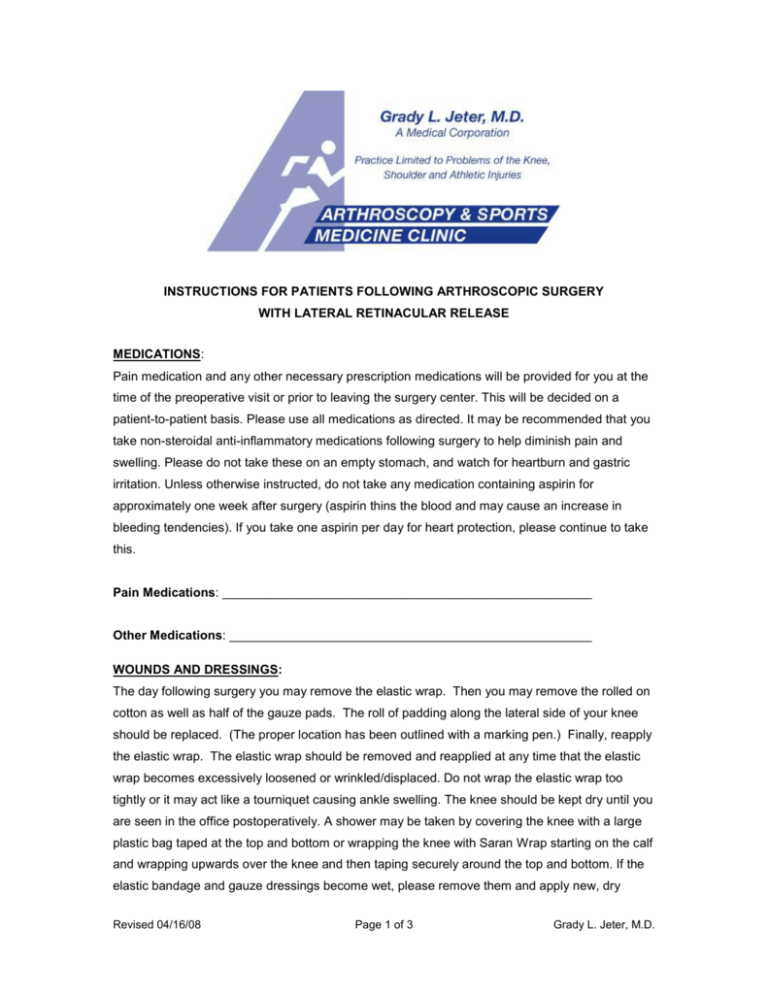
INSTRUCTIONS FOR PATIENTS FOLLOWING ARTHROSCOPIC SURGERY WITH LATERAL RETINACULAR RELEASE MEDICATIONS: Pain medication and any other necessary prescription medications will be provided for you at the time of the preoperative visit or prior to leaving the surgery center. This will be decided on a patient-to-patient basis. Please use all medications as directed. It may be recommended that you take non-steroidal anti-inflammatory medications following surgery to help diminish pain and swelling. Please do not take these on an empty stomach, and watch for heartburn and gastric irritation. Unless otherwise instructed, do not take any medication containing aspirin for approximately one week after surgery (aspirin thins the blood and may cause an increase in bleeding tendencies). If you take one aspirin per day for heart protection, please continue to take this. Pain Medications: _____________________________________________________ Other Medications: ____________________________________________________ WOUNDS AND DRESSINGS: The day following surgery you may remove the elastic wrap. Then you may remove the rolled on cotton as well as half of the gauze pads. The roll of padding along the lateral side of your knee should be replaced. (The proper location has been outlined with a marking pen.) Finally, reapply the elastic wrap. The elastic wrap should be removed and reapplied at any time that the elastic wrap becomes excessively loosened or wrinkled/displaced. Do not wrap the elastic wrap too tightly or it may act like a tourniquet causing ankle swelling. The knee should be kept dry until you are seen in the office postoperatively. A shower may be taken by covering the knee with a large plastic bag taped at the top and bottom or wrapping the knee with Saran Wrap starting on the calf and wrapping upwards over the knee and then taping securely around the top and bottom. If the elastic bandage and gauze dressings become wet, please remove them and apply new, dry Revised 04/16/08 Page 1 of 3 Grady L. Jeter, M.D. gauze pads. The elastic bandage may be dried in a dryer without heat and then reapplied. Skin tapes over the incisions should not be removed. The cotton pad and elastic wrap should be used for 7-10 days, occasionally longer. STITCHES: The small puncture wounds are held together with a single stitch, which will usually be removed on your first postoperative visit. The small skin incisions are held together with Steri-strips (skin tapes) and stay on for 7-10 days. Do not remove the Steri-strips (skin tapes) unless wet or loosened. ACTIVITIES: Unless otherwise instructed, you may immediately bear weight on your operated extremity. You are encouraged to try to walk as smoothly as possible. The local anesthetic in your knee will usually last for 8-12 hours. Be careful not to overuse the knee during this period and the following 48 hours. Normal walking is okay. Do not do any strenuous activities such as running or jumping until Dr. Jeter clears you for these activities. You may experience some discomfort as you walk. Use the pain medication provided as needed. Unless otherwise instructed, it is not necessary to use crutches. If you feel more secure with crutches, feel free to use them. You may start bending your knee as soon as you like. A cooling pad or ice packs are helpful in decreasing swelling and discomfort. If you are using ice packs, it is recommended that you maintain the ice packs on the knee nearly continuously for the first 24 hours and then 50% of the time during the second 24 hours. If you are using a cooling pad, it is also recommended that you use it nearly continuously for the first 24 hours and then 50% of the time during the second 24 hours. The cooling pad has careful instructions regarding the use of the cooling pad and use of the thermostat. It is important not to place the cooling pad on the knee unless the dressing and elastic wrap are in place. Please use great care to avoid excessive cold, as this can lead to frostbite-- ice packs or cooling pads should never be applied without ample dressing to prevent this from occurring. A small hand towel or paper towel may be placed be between the ice bag or cooling pad and your dressing to absorb excessive moisture that may accumulate on the cooling device. During the first 24 hours following surgery, please keep the operated leg above heart level as much as possible. During the subsequent 24 hours, elevate as needed for swelling or discomfort. EXERCISES: The thigh and calf musculature will shrink in size and strength quite rapidly unless you exercise it. The below listed exercises should be carried out at least 5-10 minutes of each waking hour. Revised 04/16/08 Page 2 of 3 Grady L. Jeter, M.D. 1) Start with muscle tightening (isometric) exercises for the thigh. Straighten your knee as straight as possible and clench the thigh muscles tightly and attempt to hold for 5 seconds, and then relax. Repeat 10-20 times. You should try to do a minimum of 100 tightening exercises per day in order to maintain the tone and strength in the muscle. 2) Exercise the calf muscles by making a circle with the toes (some patients find that “drawing” the alphabet with their big toe is less boring than making repeated circles with their toes). 3) Next, progress to leg lifts. Lying on your back, attempt to carry out 10-20 leg lift repetitions. Then, turning to the un-operated side, lift the operated leg upward, again attempting 10-20 repetitions. 4) The initial discomfort sometimes noted when arising from bed may be diminished if you carry out a set of leg exercises immediately prior to getting up on your feet or crutches. 5) Start gently bending your knee the day after surgery and increase the bending until full motion has returned. PROBLEMS: Please contact Dr. Jeter immediately if any of the following should occur: 1) Should you develop central tenderness in the back of your calf, please contact me immediately. Phlebitis (blood clot) is extremely rare following this type of surgery due to the early ability of the patient to carry out exercises and activity. Early detection and treatment of phlebitis can significantly reduce the magnitude of this complication. 2) Increasing knee pain not relieved by rest, ice and elevation, and pain medication. 3) Temperature of 101° or above. 4) Persisting temperature (24 hours) of 100°. If you have any other questions or problems, please feel free to call Dr. Jeter at (408) 559-4343 at any time. RETURN APPOINTMENT: If you have not already been scheduled for your first post-operative appointment, please call my office as soon as you return home following surgery to schedule this. Revised 04/16/08 Page 3 of 3 Grady L. Jeter, M.D.
